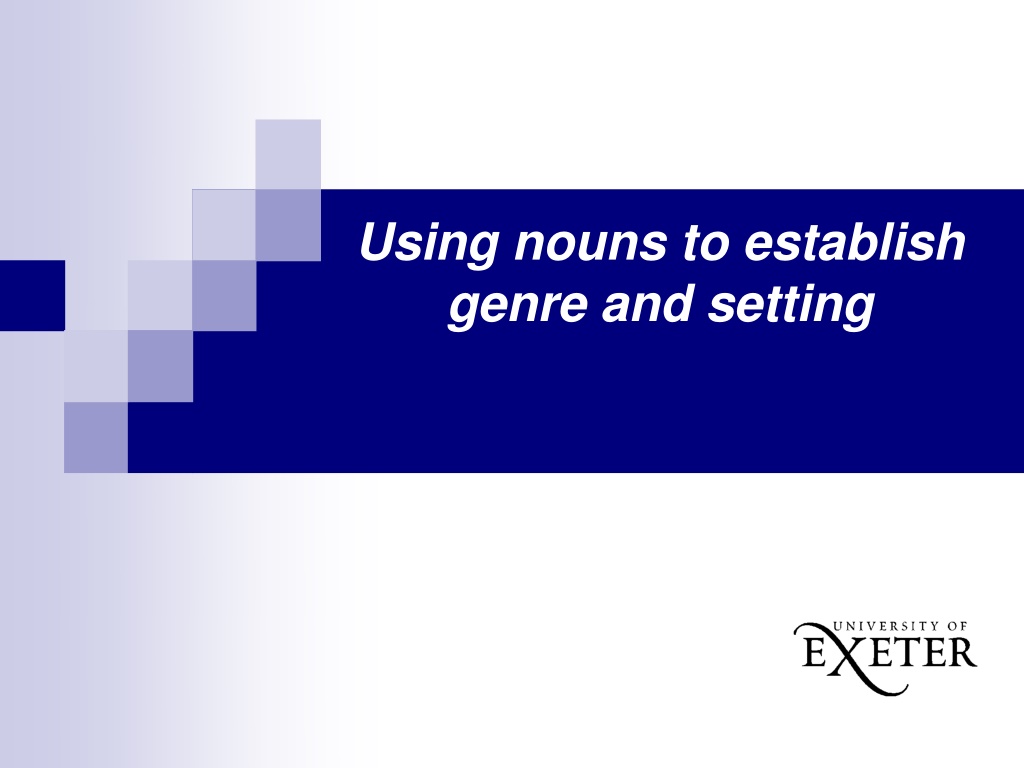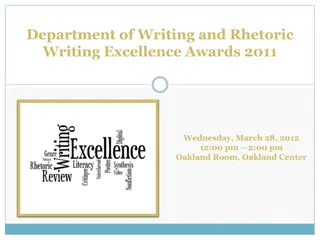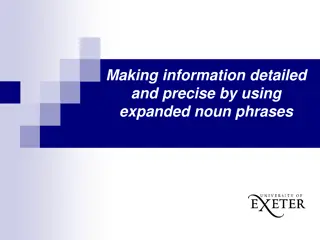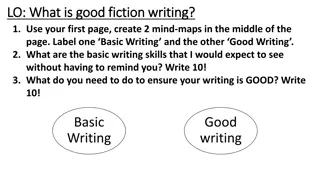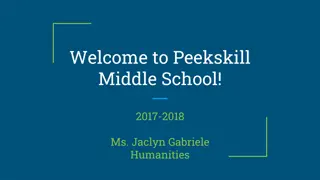Creative Noun Usage in Science Fiction Writing
Explore the art of using nouns to establish genre, setting, and character names in science fiction writing. Learn how authors like Philip Reeve utilize proper nouns to create immersive worlds and unique characters. Delve into the significance of authentic text, discussion, and purposeful learning principles in enhancing writing skills. Uncover the secrets behind choosing apt names for futuristic landscapes and robotic characters, enhancing the overall reader experience in the realm of science fiction.
Download Presentation

Please find below an Image/Link to download the presentation.
The content on the website is provided AS IS for your information and personal use only. It may not be sold, licensed, or shared on other websites without obtaining consent from the author. Download presentation by click this link. If you encounter any issues during the download, it is possible that the publisher has removed the file from their server.
E N D
Presentation Transcript
Using nouns to establish genre and setting
LEAD Principles PRINCIPLE LINKS EXPLANATION RATIONALE To establish a purposeful learning reason for addressing grammar, and connect grammar with meaning and rhetorical effect Make a link between the grammar being introduced and how it works in the writing being taught To avoid writing lessons becoming mini- grammar lessons, and to allow access to the structure even if the grammar concept is not fully understood To integrate reading and writing and show how real writers make language choices EXAMPLES Explain the grammar through examples, not lengthy explanations AUTHENTIC TEXTS Use authentic texts as models to link writers to the broader community of writers To promote deep metalinguistic learning about why a particular choice works, and to develop independence rather than compliance DISCUSSION Build in high-quality discussion about grammar and its effects
What genre is this story? What might the setting be like for this story? What might be the names of places and objects in the story? What might the writer want to do for the reader in naming these places and objects? Genre and Setting Authentic text Discussion
Choosing names for science fiction Getting the names right is half the battle you can do a lot of worldbuilding simply by deciding what people and places are called. When I started writing the story which became Railhead I tried to make sure the names sounded different. I called my central characters Zen and Nova because those were the sorts of names I remember from futuristic stories and TV shows that were around when I was a child they re sci-fi names. I knew that in German-speaking cities there are often railway lines called the U-bahn and the S-bahn. My interstellar empire would be linked by the K-bahn, whose trains would go through K-gates and flash across a dimension called K-space to reach their far destinations. Philip Reeve
Choosing a science-fiction name: your turn! What if robots were in control of the world? What do you think this robot s job might be? What name would you give it that suggests its role?
Using Proper Nouns to describe a science fiction setting Zen s hometown was a sheer-sided ditch of a place. Cleave s houses and factories were packed like shelved crates up each wall of a mile-deep canyon on a one-gate world called Angkat whose surface was scoured by constant storms. Space was scarce, so the buildings huddled into every available scrap of terracing, and clung to cliff faces, and crowded on the bridges which stretched across the gulf between the canyon walls a gulf which was filled with sagging cables, dangling neon signage, smog, dirty rain, and the fluttering rotors of air taxis, ferries and corporate transports. Between the steep-stacked buildings a thousand waterfalls went foaming down to join the river far below, adding their own roar to the various dins from the industrial zone. The local name for Cleave was Thunder City. Links From Railhead by Philip Reeve Examples What impression of this place do you get? Would you want to live there? What more do the highlighted place names tell you? Discussion
Using concrete nouns to describe a science fiction setting Zen s hometown was a sheer-sided ditch of a place. Cleave s houses and factories were packed like shelved crates up each wall of a mile- deep canyon on a one-gate world called Angkat whose surface was scoured by constant storms. Space was scarce, so the buildings huddled into every available scrap of terracing, and clung to cliff faces, and crowded on the bridges which stretched across the gulf between the canyon walls a gulf which was filled with sagging cables, dangling neon signage, smog, dirty rain, and the fluttering rotors of air taxis, ferries and corporate transports. Between the steep-stacked buildings a thousand waterfalls went foaming down to join the river far below, adding their own roar to the various dins from the industrial zone. The local name for Cleave was Thunder City. Why do you think there are so many objects listed in this description? What things are familiar to you? What things are more unusual? Would you want to live in this place? Why, or why not?
How well does the image match the description? db0fdf28e33a1a5d5b15f9c727f1c76e Cleave s houses and factories were packed like shelved crates up each wall of a mile-deep canyon on a one-gate world called Angkat whose surface was scoured by constant storms. Space was scarce, so the buildings huddled available scrap of terracing, and clung to cliff faces, and crowded on the bridges which stretched across the gulf between the canyon walls a gulf which was filled with sagging cables, dangling neon signage, smog, dirty rain, and the fluttering rotors of air taxis, ferries and corporate transports. into every
Verbalising the Grammar-Writing Link A crucial element of the LEAD principles is helping writers to think explicitly (metalinguistically) about the choices they make. As a teacher, you need to support this by being crystal clear yourself about how you verbalise the link between a grammar choice and its effect in a particular text/context. Then express this in student-friendly language, as below. Verbalisation to share with students: When you are writing narrative, you can help your reader to understand the genre of your story and to visualise important settings within it. Choose your Proper and concrete nouns carefully! Ask yourself what you want your reader to see, think and feel about the setting that you re describing.
Imagine this is the setting for a science fiction story. Choose Proper Nouns to name the city and/or buildings in it and concrete nouns to list some of the things you might see or hear. Your aim is to use nouns that help your reader to imagine what it would be like to live in this place. Focus on noun choice as you write the opening sentences to the story.
